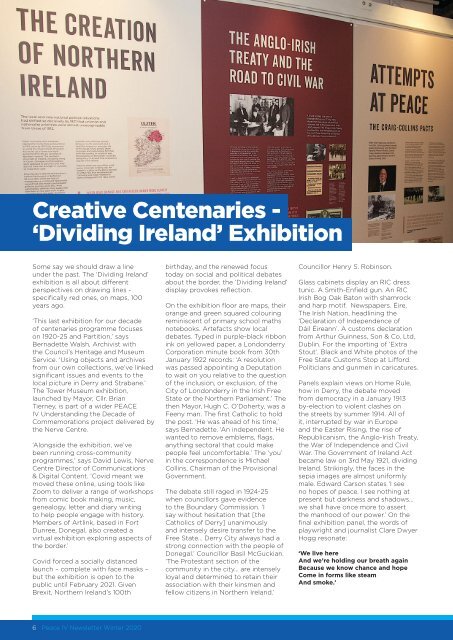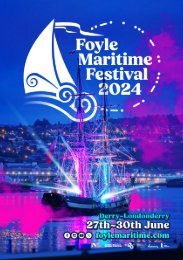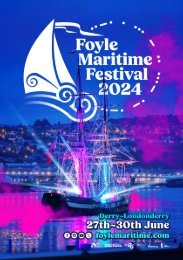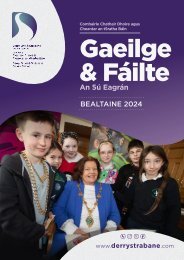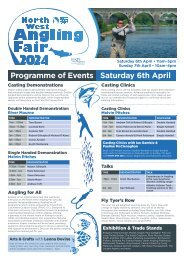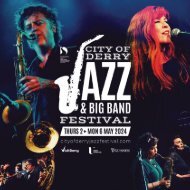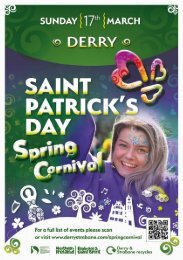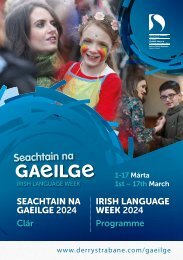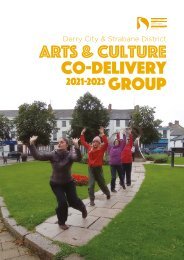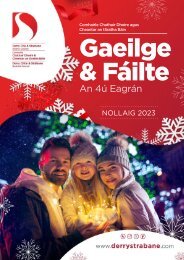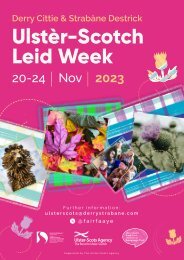Peace IV Newsletter November 2020
Create successful ePaper yourself
Turn your PDF publications into a flip-book with our unique Google optimized e-Paper software.
Creative Centenaries -<br />
‘Dividing Ireland’ Exhibition<br />
Some say we should draw a line<br />
under the past. The ‘Dividing Ireland’<br />
exhibition is all about different<br />
perspectives on drawing lines -<br />
specifically red ones, on maps, 100<br />
years ago.<br />
‘This last exhibition for our decade<br />
of centenaries programme focuses<br />
on 1920-25 and Partition,’ says<br />
Bernadette Walsh, Archivist with<br />
the Council’s Heritage and Museum<br />
Service. ‘Using objects and archives<br />
from our own collections, we’ve linked<br />
significant issues and events to the<br />
local picture in Derry and Strabane.’<br />
The Tower Museum exhibition,<br />
launched by Mayor, Cllr. Brian<br />
Tierney, is part of a wider PEACE<br />
<strong>IV</strong> Understanding the Decade of<br />
Commemorations project delivered by<br />
the Nerve Centre.<br />
‘Alongside the exhibition, we’ve<br />
been running cross-community<br />
programmes,’ says David Lewis, Nerve<br />
Centre Director of Communications<br />
& Digital Content. ‘Covid meant we<br />
moved these online, using tools like<br />
Zoom to deliver a range of workshops<br />
from comic book making, music,<br />
genealogy, letter and diary writing<br />
to help people engage with history.<br />
Members of Artlink, based in Fort<br />
Dunree, Donegal, also created a<br />
virtual exhibition exploring aspects of<br />
the border.’<br />
Covid forced a socially distanced<br />
launch – complete with face masks –<br />
but the exhibition is open to the<br />
public until February 2021. Given<br />
Brexit, Northern Ireland’s 100th<br />
birthday, and the renewed focus<br />
today on social and political debates<br />
about the border, the ‘Dividing Ireland’<br />
display provokes reflection.<br />
On the exhibition floor are maps, their<br />
orange and green squared colouring<br />
reminiscent of primary school maths<br />
notebooks. Artefacts show local<br />
debates. Typed in purple-black ribbon<br />
ink on yellowed paper, a Londonderry<br />
Corporation minute book from 30th<br />
January 1922 records: ‘A resolution<br />
was passed appointing a Deputation<br />
to wait on you relative to the question<br />
of the inclusion, or exclusion, of the<br />
City of Londonderry in the Irish Free<br />
State or the Northern Parliament.’ The<br />
then Mayor, Hugh C. O’Doherty, was a<br />
Feeny man. The first Catholic to hold<br />
the post. ‘He was ahead of his time,’<br />
says Bernadette. ‘An independent. He<br />
wanted to remove emblems, flags,<br />
anything sectoral that could make<br />
people feel uncomfortable.’ The ‘you’<br />
in the correspondence is Michael<br />
Collins, Chairman of the Provisional<br />
Government.<br />
The debate still raged in 1924-25<br />
when councillors gave evidence<br />
to the Boundary Commission. ‘I<br />
say without hesitation that [the<br />
Catholics of Derry] unanimously<br />
and intensely desire transfer to the<br />
Free State… Derry City always had a<br />
strong connection with the people of<br />
Donegal.’ Councillor Basil McGuckian.<br />
‘The Protestant section of the<br />
community in the city… are intensely<br />
loyal and determined to retain their<br />
association with their kinsmen and<br />
fellow citizens in Northern Ireland.’<br />
Councillor Henry S. Robinson.<br />
Glass cabinets display an RIC dress<br />
tunic. A Smith-Enfield gun. An RIC<br />
Irish Bog Oak Baton with shamrock<br />
and harp motif. Newspapers. Éire,<br />
The Irish Nation, headlining the<br />
‘Declaration of Independence of<br />
Dáil Éireann’. A customs declaration<br />
from Arthur Guinness, Son & Co, Ltd,<br />
Dublin. For the importing of ‘Extra<br />
Stout’. Black and White photos of the<br />
Free State Customs Stop at Lifford.<br />
Politicians and gunmen in caricatures.<br />
Panels explain views on Home Rule,<br />
how in Derry, the debate moved<br />
from democracy in a January 1913<br />
by-election to violent clashes on<br />
the streets by summer 1914. All of<br />
it, interrupted by war in Europe<br />
and the Easter Rising, the rise of<br />
Republicanism, the Anglo-Irish Treaty,<br />
the War of Independence and Civil<br />
War. The Government of Ireland Act<br />
became law on 3rd May 1921, dividing<br />
Ireland. Strikingly, the faces in the<br />
sepia images are almost uniformly<br />
male. Edward Carson states ‘I see<br />
no hopes of peace. I see nothing at<br />
present but darkness and shadows…<br />
we shall have once more to assert<br />
the manhood of our power.’ On the<br />
final exhibition panel, the words of<br />
playwright and journalist Clare Dwyer<br />
Hogg resonate:<br />
‘We live here<br />
And we’re holding our breath again<br />
Because we know chance and hope<br />
Come in forms like steam<br />
And smoke.’<br />
6 <strong>Peace</strong> <strong>IV</strong> <strong>Newsletter</strong> Winter <strong>2020</strong>


